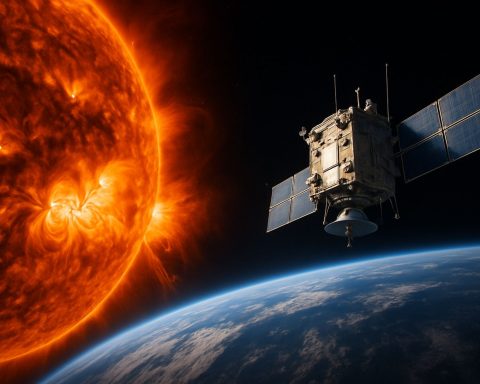Solar Tempests & Orbital Guardians: Inside the High-Stakes Realm of Space-Weather Satellite Defense and Innovation
- Space-Weather Satellite Market: Scope and Dynamics
- Emerging Technologies Shaping Space-Weather Monitoring
- Key Players and Strategic Positioning in the Sector
- Projected Expansion and Investment Opportunities
- Geographic Hotspots and Regional Market Drivers
- Next-Generation Capabilities and Industry Trajectories
- Navigating Risks and Unlocking Potential in Space-Weather Satellite Operations
- Sources & References
“The ESA's BIOMASS Earth observation satellite has produced its first focused SAR image in the P-band from space—a world first.” (source)
Space-Weather Satellite Market: Scope and Dynamics
The space-weather satellite market is rapidly evolving as the world becomes increasingly reliant on space-based infrastructure and digital connectivity. At the heart of this market are satellites designed to monitor and forecast solar tempests—violent eruptions from the Sun such as solar flares and coronal mass ejections (CMEs)—that can disrupt power grids, satellite communications, navigation systems, and even pose risks to astronauts. These “orbital guardians” play a crucial, often underappreciated, role in safeguarding modern society from the unpredictable forces of space weather.
Market Scope
- Applications: Space-weather satellites serve a diverse range of end-users, including government agencies (e.g., NOAA, ESA, NASA), defense organizations, commercial satellite operators, and research institutions. Their data is vital for early warning systems, risk mitigation, and operational planning across sectors such as aviation, telecommunications, and energy.
- Satellite Types: The market encompasses geostationary, low-Earth orbit (LEO), and deep-space observatories. Notable examples include the GOES-R series (NOAA), ESA’s Vigil mission, and NASA’s Solar Dynamics Observatory.
- Market Size: The global space-weather monitoring market was valued at approximately $1.1 billion in 2023 and is projected to grow at a CAGR of 8.2% through 2028, driven by increasing satellite launches and heightened awareness of space-weather risks.
Market Dynamics
- Drivers: The surge in satellite constellations (e.g., Starlink, OneWeb), the electrification of critical infrastructure, and the upcoming solar maximum (expected in 2025) are intensifying demand for real-time space-weather data (NOAA SWPC).
- Challenges: High development costs, technological complexity, and the need for international data sharing remain significant hurdles. Additionally, the unpredictable nature of solar activity complicates forecasting and risk assessment.
- Opportunities: Advances in miniaturization, AI-driven data analytics, and public-private partnerships are opening new avenues for commercial players and startups to enter the market (SpaceNews).
As solar tempests loom, the “secret life” of space-weather satellites is becoming ever more critical. Their silent vigilance ensures the resilience of our interconnected world, making them indispensable assets in the space economy.
Emerging Technologies Shaping Space-Weather Monitoring
Space weather—driven by solar tempests such as flares and coronal mass ejections—poses significant risks to satellites, power grids, and communication systems on Earth. As our reliance on space-based infrastructure grows, so does the need for advanced monitoring technologies. At the forefront of this effort are space-weather satellites, often dubbed “orbital guardians,” which provide real-time data and early warnings to mitigate the impact of solar storms.
Recent years have seen a surge in the deployment and sophistication of these satellites. The Solar Dynamics Observatory (SDO) and the GOES-16 and GOES-17 satellites, operated by NASA and NOAA, continuously monitor the Sun’s activity, capturing high-resolution images and measuring solar radiation. These platforms are equipped with advanced sensors, such as the Extreme Ultraviolet Variability Experiment (EVE) and the Solar Ultraviolet Imager (SUVI), which enable detailed analysis of solar eruptions and their potential to disrupt Earth’s magnetosphere.
Emerging technologies are further enhancing space-weather monitoring capabilities:
- Miniaturized Sensors: The development of compact, high-sensitivity instruments allows for the deployment of constellations of small satellites (CubeSats), increasing spatial coverage and data redundancy. Projects like NASA’s CubeSat Launch Initiative are pioneering this approach.
- Artificial Intelligence (AI): AI-driven analytics are being integrated to process vast streams of solar data, enabling faster detection of anomalies and more accurate forecasting. The European Space Agency (ESA) is actively researching AI applications for space-weather prediction.
- Interplanetary Monitoring: Missions like Parker Solar Probe and Solar Orbiter are venturing closer to the Sun than ever before, gathering unprecedented data on solar wind and magnetic fields, which is crucial for understanding and predicting solar storms.
According to the NOAA Space Weather Prediction Center, the frequency and intensity of solar activity are expected to rise as we approach the solar maximum in 2025, underscoring the importance of these technological advancements. As the “secret life” of space-weather satellites becomes increasingly vital, their role as orbital guardians will only grow, safeguarding both terrestrial and space-based assets from the Sun’s volatile temperament.
Key Players and Strategic Positioning in the Sector
The sector of space-weather monitoring is increasingly vital as solar activity intensifies and human reliance on satellite infrastructure grows. The main players in this domain—government agencies, private companies, and international collaborations—are strategically positioning themselves to provide real-time data, predictive analytics, and mitigation strategies for solar storms and other space-weather phenomena.
- NOAA (National Oceanic and Atmospheric Administration): Through its GOES and DSCOVR satellites, NOAA is a global leader in space-weather monitoring. The Space Weather Prediction Center (SWPC) provides real-time alerts and forecasts, crucial for aviation, power grids, and satellite operators.
- ESA (European Space Agency): ESA’s Space Weather Office coordinates the Space Weather Service Network, integrating data from satellites like Swarm and the upcoming Lagrange mission (launching mid-2020s) to provide early warnings of solar storms.
- NASA: NASA’s Solar Dynamics Observatory (SDO) and STEREO missions deliver high-resolution solar imagery and 3D views of solar eruptions, supporting both research and operational forecasting.
- Private Sector: Companies like Spire Global and Planet Labs are leveraging nanosatellite constellations to supplement traditional government data, offering commercial space-weather analytics for industries such as aviation, insurance, and energy.
- International Collaboration: The World Meteorological Organization and UN Committee on the Peaceful Uses of Outer Space facilitate data sharing and joint response protocols, recognizing that space weather is a transnational risk.
Strategically, these players are investing in next-generation satellites positioned at key orbital points—such as the L1 and L5 Lagrange points—to maximize early warning capabilities. The sector is also seeing a shift toward AI-driven analytics and cloud-based data platforms, enabling faster, more actionable insights for both public and private stakeholders (SpaceNews). As solar cycle 25 ramps up, the race to monitor and mitigate “solar tempests” is intensifying, with both established agencies and agile startups vying for a critical role in safeguarding Earth’s technological infrastructure.
Projected Expansion and Investment Opportunities
The projected expansion of the space-weather satellite sector is being driven by the increasing recognition of solar storms—often termed “solar tempests”—as a critical threat to modern infrastructure. These tempests, caused by solar flares and coronal mass ejections, can disrupt power grids, satellite communications, and navigation systems. As a result, governments and private entities are ramping up investments in “orbital guardians”: satellites specifically designed to monitor, predict, and mitigate the effects of space weather.
According to the MarketsandMarkets report, the global space situational awareness market—which includes space-weather monitoring—was valued at $1.5 billion in 2023 and is projected to reach $1.8 billion by 2028, growing at a CAGR of 3.7%. The U.S. National Oceanic and Atmospheric Administration (NOAA) has announced plans for the next-generation Space Weather Follow-On (SWFO) satellites, with launches scheduled through 2025, reflecting a broader trend of public investment.
Private sector involvement is also accelerating. Companies like Spire Global and Planet Labs are expanding their satellite constellations to include space-weather monitoring capabilities, leveraging commercial data for both governmental and industrial clients. The European Space Agency (ESA) is investing €500 million in its Space Weather Office and the upcoming Vigil mission, set to launch in 2025, which will provide real-time solar monitoring from a unique vantage point.
- Investment Opportunities:
- Satellite Manufacturing: Demand for radiation-hardened components and advanced sensors is rising.
- Data Analytics: Startups offering AI-driven space-weather forecasting are attracting venture capital.
- Insurance: New insurance products are emerging to cover space-weather-related risks for satellites and terrestrial assets.
- Public-Private Partnerships: Governments are seeking commercial partners for data sharing and rapid deployment of new technologies.
With the frequency and severity of solar tempests expected to increase as the Sun approaches its next solar maximum in 2025 (NOAA SWPC), the market for orbital guardians is poised for robust growth. Investors and innovators who position themselves in this sector now stand to benefit from both the expanding market and the critical role these satellites play in safeguarding global infrastructure.
Geographic Hotspots and Regional Market Drivers
The global market for space-weather satellites is rapidly evolving, driven by the increasing frequency and intensity of solar tempests—solar flares and coronal mass ejections—that threaten terrestrial and orbital infrastructure. These satellites, often dubbed “orbital guardians,” play a critical role in monitoring and forecasting space weather events, providing early warnings to protect power grids, aviation, and satellite communications.
Geographic Hotspots
- United States: The U.S. leads the market, with agencies like NASA and NOAA operating key satellites such as the GOES-R series and the Solar Dynamics Observatory (SDO). The U.S. government’s 2024 budget allocates over $2.3 billion for space weather monitoring and research (White House FY2024 Budget).
- European Union: The EU, through the European Space Agency (ESA), is investing in the Lagrange mission to monitor solar activity from the L5 Lagrange point, with a launch planned for 2027.
- China: China’s Advanced Space-based Solar Observatory (ASO-S) launched in 2022, marking a significant step in the nation’s ambitions to become a leader in space weather forecasting.
- Japan and India: Both countries are expanding their capabilities, with Japan’s Hinode and India’s Aditya-L1 missions focusing on solar observation and space weather prediction.
Regional Market Drivers
- Infrastructure Vulnerability: North America and Europe, with their dense power grids and reliance on satellite communications, are especially vulnerable to geomagnetic storms, driving demand for advanced monitoring systems (National Academies).
- Commercial Satellite Growth: The proliferation of commercial satellites, especially in Asia-Pacific, is increasing the need for real-time space weather data to mitigate operational risks (SpaceTech Market Report 2023).
- International Collaboration: Cross-border initiatives, such as the International Space Environment Service (ISES), are fostering data sharing and joint missions, further fueling market growth.
As solar activity intensifies in the current solar cycle, the demand for space-weather satellites is expected to surge, with the market projected to reach $2.1 billion by 2028 (MarketsandMarkets).
Next-Generation Capabilities and Industry Trajectories
Space-weather satellites play a pivotal role in monitoring and mitigating the effects of solar tempests—powerful eruptions from the Sun that can disrupt terrestrial and orbital technologies. As our reliance on satellite communications, navigation, and power grids intensifies, the next generation of space-weather monitoring systems is rapidly evolving to address emerging threats and capitalize on new opportunities.
Next-Generation Capabilities
- Real-Time Data and AI Integration: Modern space-weather satellites, such as NASA’s Solar Dynamics Observatory (SDO) and the European Space Agency’s Solar Orbiter, are equipped with advanced sensors and AI-driven analytics. These systems provide near-instantaneous alerts on solar flares, coronal mass ejections (CMEs), and geomagnetic storms, enabling faster response times for critical infrastructure operators.
- Constellation Deployments: The industry is shifting from single-point observation to distributed constellations. For example, the U.S. National Oceanic and Atmospheric Administration (NOAA) is developing the Space Weather Follow On (SWFO) mission, which will deploy multiple satellites at strategic Lagrange points for comprehensive solar monitoring.
- Miniaturization and Commercialization: The rise of small satellites and CubeSats, such as those launched by Spire Global and Planet Labs, is democratizing access to space-weather data. These platforms offer cost-effective, scalable solutions for both government and private sector clients.
Industry Trajectories
- Market Growth: The global space weather monitoring market is projected to reach $1.5 billion by 2028, driven by increased investment in satellite infrastructure and the growing threat of solar storms to critical systems.
- Public-Private Partnerships: Collaboration between agencies like NASA, ESA, and private firms is accelerating innovation. Initiatives such as the Heliophysics Environmental and Radiation Measurement Experiment Suite (HERMES) exemplify this trend.
- Resilience and Security: As the risk of “solar tempests” grows, governments are prioritizing space-weather resilience in national security strategies, with new policies and funding streams emerging in the U.S., EU, and Asia-Pacific regions.
In summary, the secret life of space-weather satellites is becoming increasingly public—and indispensable—as next-generation capabilities and industry trajectories converge to safeguard our digital and orbital future.
Navigating Risks and Unlocking Potential in Space-Weather Satellite Operations
Space-weather satellites play a pivotal role in monitoring and mitigating the risks posed by solar tempests—intense bursts of solar activity such as solar flares and coronal mass ejections (CMEs). These phenomena can disrupt satellite communications, navigation systems, and even terrestrial power grids, making the work of these “orbital guardians” essential for modern infrastructure.
Understanding Solar Tempests
- Solar tempests are driven by the Sun’s 11-year activity cycle, with the current Solar Cycle 25 expected to peak between 2024 and 2025. Recent data from NASA and NOAA indicate an uptick in solar flare activity, with several X-class flares recorded in early 2024 (NOAA SWPC).
- CMEs can eject billions of tons of plasma toward Earth, compressing the planet’s magnetic field and inducing geomagnetic storms. The infamous 1989 Quebec blackout and the 2003 “Halloween Storms” are stark reminders of the potential impact (NASA).
The Role of Space-Weather Satellites
- Satellites such as NOAA’s GOES series, NASA’s Solar Dynamics Observatory (SDO), and the European Space Agency’s Solar Orbiter provide real-time monitoring of solar activity, enabling early warnings for at-risk sectors (NOAA GOES-16).
- These satellites use advanced imaging and magnetometry to track solar eruptions, measure solar wind, and model the propagation of space weather events toward Earth.
- Data from these platforms feed into global alert systems, allowing operators of power grids, airlines, and satellite fleets to take preemptive measures—such as powering down sensitive equipment or rerouting flights (NOAA Alerts).
Unlocking Potential and Navigating Risks
- With the commercial satellite market projected to reach $308.3 billion by 2030 (GlobeNewswire), the demand for robust space-weather forecasting is surging.
- Emerging technologies, such as AI-driven anomaly detection and international data-sharing initiatives, are enhancing the resilience of satellite operations against solar threats (ESA).
As solar activity intensifies, the “secret life” of space-weather satellites becomes ever more critical—serving as both sentinels and shields for the world’s increasingly space-reliant economy.
Sources & References
- Solar Tempests & Orbital Guardians: The Secret Life of Space-Weather Satellites
- NOAA GOES-16
- ESA
- NASA
- $1.5 billion by 2028
- NOAA Alerts
- SpaceNews
- Space Weather Service Network
- Planet Labs
- World Meteorological Organization
- White House FY2024 Budget
- Advanced Space-based Solar Observatory (ASO-S)
- Hinode
- Aditya-L1
- National Academies
- GlobeNewswire








